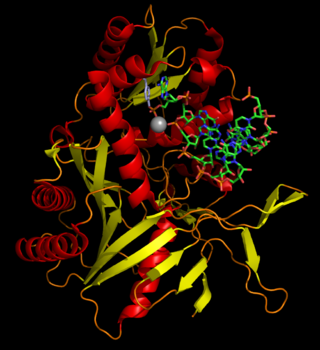
The Nitrosomonadales are an order of the class Betaproteobacteria in the phylum Pseudomonadota. Like all members of their class, they are Gram-negative.
The Desulfobacteraceae are a family of Thermodesulfobacteriota. They reduce sulfates to sulfides to obtain energy and are strictly anaerobic. They have a respiratory and fermentative type of metabolism. Some species are chemolithotrophic and use inorganic materials to obtain energy and use hydrogen as their electron donor.

Sulfate-reducing microorganisms (SRM) or sulfate-reducing prokaryotes (SRP) are a group composed of sulfate-reducing bacteria (SRB) and sulfate-reducing archaea (SRA), both of which can perform anaerobic respiration utilizing sulfate (SO2−
4) as terminal electron acceptor, reducing it to hydrogen sulfide (H2S). Therefore, these sulfidogenic microorganisms "breathe" sulfate rather than molecular oxygen (O2), which is the terminal electron acceptor reduced to water (H2O) in aerobic respiration.

The Thermodesulfobacteriota are a phylum of thermophilic sulfate-reducing bacteria. They are a gram-negitive bacteria [1]

Archaeoglobaceae are a family of the Archaeoglobales. All known genera within the Archaeoglobaceae are hyperthermophilic and can be found near undersea hydrothermal vents. Archaeoglobaceae are the only family in the order Archaeoglobales, which is the only order in the class Archaeoglobi.
Archaeoglobus is a genus of the phylum Euryarchaeota. Archaeoglobus can be found in high-temperature oil fields where they may contribute to oil field souring.

Sulfur-reducing bacteria are microorganisms able to reduce elemental sulfur (S0) to hydrogen sulfide (H2S). These microbes use inorganic sulfur compounds as electron acceptors to sustain several activities such as respiration, conserving energy and growth, in absence of oxygen. The final product of these processes, sulfide, has a considerable influence on the chemistry of the environment and, in addition, is used as electron donor for a large variety of microbial metabolisms. Several types of bacteria and many non-methanogenic archaea can reduce sulfur. Microbial sulfur reduction was already shown in early studies, which highlighted the first proof of S0 reduction in a vibrioid bacterium from mud, with sulfur as electron acceptor and H
2 as electron donor. The first pure cultured species of sulfur-reducing bacteria, Desulfuromonas acetoxidans, was discovered in 1976 and described by Pfennig Norbert and Biebel Hanno as an anaerobic sulfur-reducing and acetate-oxidizing bacterium, not able to reduce sulfate. Only few taxa are true sulfur-reducing bacteria, using sulfur reduction as the only or main catabolic reaction. Normally, they couple this reaction with the oxidation of acetate, succinate or other organic compounds. In general, sulfate-reducing bacteria are able to use both sulfate and elemental sulfur as electron acceptors. Thanks to its abundancy and thermodynamic stability, sulfate is the most studied electron acceptor for anaerobic respiration that involves sulfur compounds. Elemental sulfur, however, is very abundant and important, especially in deep-sea hydrothermal vents, hot springs and other extreme environments, making its isolation more difficult. Some bacteria – such as Proteus, Campylobacter, Pseudomonas and Salmonella – have the ability to reduce sulfur, but can also use oxygen and other terminal electron acceptors.
Desulfovirgula is a genus of sulfate reducing, anaerobic, endospore-forming, Gram-positive, thermophilic, motile, rod-shaped bacteria, isolated from an underground mining site in an area of Japan characterized by high geothermal activity.
Desulfosporosinus is a genus of strictly anaerobic, sulfate-reducing bacteria, often found in soil.
Thermodesulfobacterium hydrogeniphilum is a species of Sulfate-reducing bacteria. It is thermophilic, chemolithoautotrophic, non-spore-forming, marine species, with type strain SL6T.
Desulfacinum infernum is a thermophilic sulfate-reducing bacterium, the type species of its genus. Its cells are oval, 1.5 by 2.5-3μm, non-motile and gram-negative.
Desulfovibrio alcoholivorans is a bacterium from the genus of Desulfovibrio which has been isolated from alcohol industry waste water in France.
Desulfofaba is a Gram-negative, anaerobic, non-spore-forming and motile bacteria genus from the family of Desulfobacteraceae.
Desulfatirhabdium is a bacteria genus from the order Desulfobacterales.
Desulfoconvexum is a bacteria genus from the family of Desulfobacteraceae with one known species.
Desulfofrigus is a Gram-negative, strictly anaerobic and non-spore-forming bacteria genus from the family of Desulfobacteraceae.
Desulfofaba gelida is a Gram-negative, sulfate-reducing and psychrophilic bacterium from the genus of Desulfofaba which has been isolated from marine mud from Hornsund in Norway.
Desulfonatronovibrio is a Gram-negative, vibrios, anaerobic and motile genus of bacteria from the family of Desulfohalobiaceae with a single polar flagellum.
Thermodesulfobium is a Gram-negative, strictly anaerobic, moderately thermophilic, non-spore-forming and non-motile genus of bacteria from the family of Thermodesulfobiaceae.

Thermodesulfobacterium hveragerdense is a bacterial species belonging to genus Thermodesulfobacterium, which are thermophilic sulfate-reducing bacteria. This species is found in aquatic areas of high temperature, and lives in freshwater like most, but not all Thermodesulfobacterium species It was first isolated from hotsprings in Iceland.




